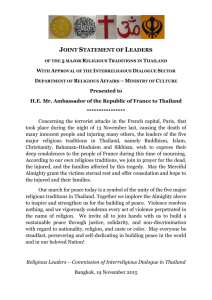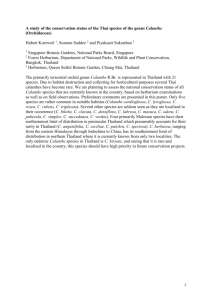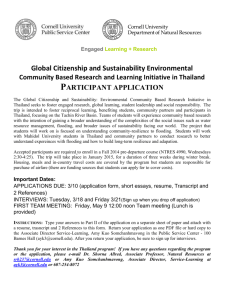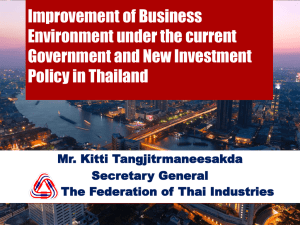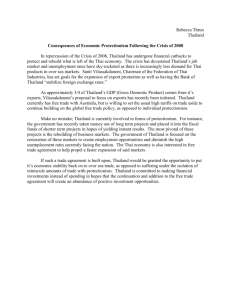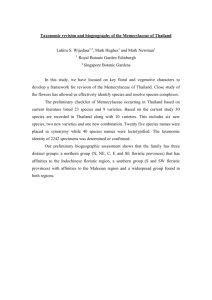Economy in History: Thailand and the Wheel of Commerce
advertisement
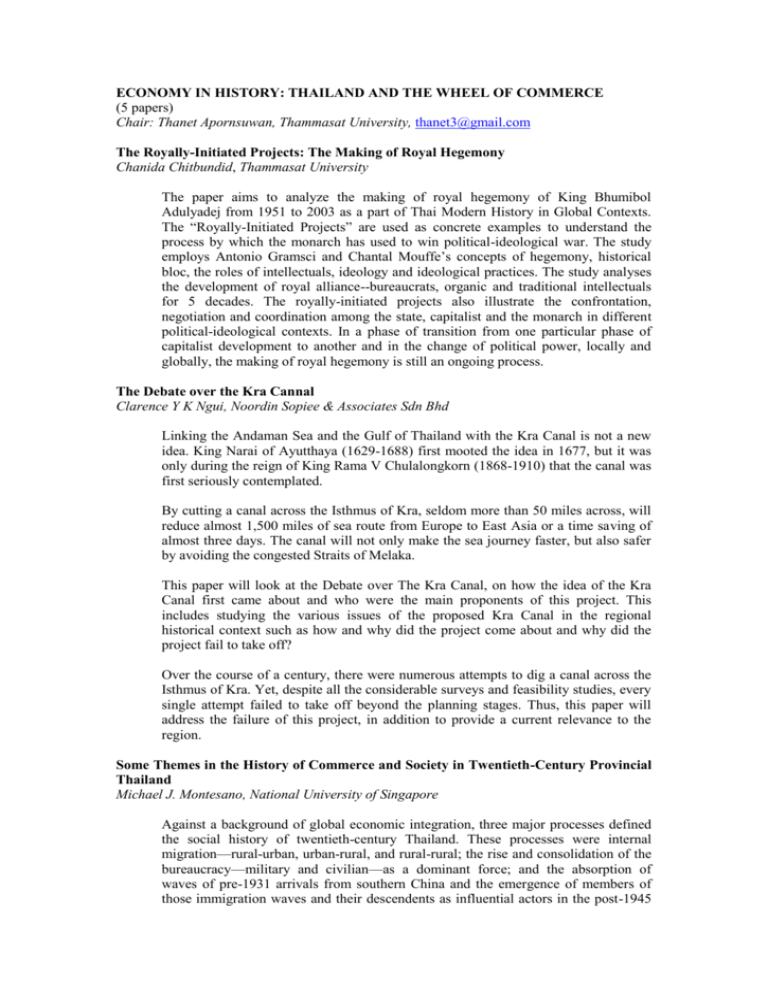
ECONOMY IN HISTORY: THAILAND AND THE WHEEL OF COMMERCE (5 papers) Chair: Thanet Apornsuwan, Thammasat University, thanet3@gmail.com The Royally-Initiated Projects: The Making of Royal Hegemony Chanida Chitbundid, Thammasat University The paper aims to analyze the making of royal hegemony of King Bhumibol Adulyadej from 1951 to 2003 as a part of Thai Modern History in Global Contexts. The “Royally-Initiated Projects” are used as concrete examples to understand the process by which the monarch has used to win political-ideological war. The study employs Antonio Gramsci and Chantal Mouffe’s concepts of hegemony, historical bloc, the roles of intellectuals, ideology and ideological practices. The study analyses the development of royal alliance--bureaucrats, organic and traditional intellectuals for 5 decades. The royally-initiated projects also illustrate the confrontation, negotiation and coordination among the state, capitalist and the monarch in different political-ideological contexts. In a phase of transition from one particular phase of capitalist development to another and in the change of political power, locally and globally, the making of royal hegemony is still an ongoing process. The Debate over the Kra Cannal Clarence Y K Ngui, Noordin Sopiee & Associates Sdn Bhd Linking the Andaman Sea and the Gulf of Thailand with the Kra Canal is not a new idea. King Narai of Ayutthaya (1629-1688) first mooted the idea in 1677, but it was only during the reign of King Rama V Chulalongkorn (1868-1910) that the canal was first seriously contemplated. By cutting a canal across the Isthmus of Kra, seldom more than 50 miles across, will reduce almost 1,500 miles of sea route from Europe to East Asia or a time saving of almost three days. The canal will not only make the sea journey faster, but also safer by avoiding the congested Straits of Melaka. This paper will look at the Debate over The Kra Canal, on how the idea of the Kra Canal first came about and who were the main proponents of this project. This includes studying the various issues of the proposed Kra Canal in the regional historical context such as how and why did the project come about and why did the project fail to take off? Over the course of a century, there were numerous attempts to dig a canal across the Isthmus of Kra. Yet, despite all the considerable surveys and feasibility studies, every single attempt failed to take off beyond the planning stages. Thus, this paper will address the failure of this project, in addition to provide a current relevance to the region. Some Themes in the History of Commerce and Society in Twentieth-Century Provincial Thailand Michael J. Montesano, National University of Singapore Against a background of global economic integration, three major processes defined the social history of twentieth-century Thailand. These processes were internal migration—rural-urban, urban-rural, and rural-rural; the rise and consolidation of the bureaucracy—military and civilian—as a dominant force; and the absorption of waves of pre-1931 arrivals from southern China and the emergence of members of those immigration waves and their descendents as influential actors in the post-1945 period. Despite the significance of these processes, the study of mid-twentiethcentury Thailand long fell through historiographic cracks. Scholarship on developments between the 1930s and the 1980s focused on politics and on Bangkok. Recently, academic studies and various other sources have reached sufficient critical mass to permit scholars to advance a number of broad, general themes in the social history of provincial Thailand during the period. Similarly, older scholarship bears rereading with such themes in mind. This paper introduces themes in the history of commerce and society in twentieth-century provincial Thailand for evaluation and debate. It offers a preliminary examination of the ways in which the three major processes in twentieth-century Thai social history played out in provincial settings. Focus falls on provincial commercial and administrative centers, on the patterns of social and economic change that marked those centers, and on the implications of those patterns for relations between Bangkok and the provinces. In moving beyond what has long remained at best a stylized view of provincial histories, the paper emphasizes the historical roots of the social and economic diversity of contemporary Thailand. Sino-Siamese Human Interaction: The Bangkok-Guangzhou Route 1767-1854 Murao Susumu, Tenri University; and Masuda Erika, Center for Asia-Pacific Area Studies, Academia Sinica The rise and fall of the Sino-Siamese junk trade has been a well-researched topic of Sino-Siamese relations during the pre-modern period. Previous studies provided two main contributions. The first was to prove the predominant position of external trade in the form of a crown monopoly for the economy of the Siamese court. The second was to demonstrate the role and activities of the Chinese traders who engaged in the Sino-Siamese junk trade and their partnership with the Siamese ruling class through economic activities. However, since those studies focused attention mainly on commercial transactions, little is known about the cultural and political aspects of activities and interactions between groups of people who directly participated in Sino-Siamese mutual communication. These participants include Chinese intermediaries, Siamese tributary envoys and Chinese local authorities. In order to explore the multi-faceted interaction among the above-mentioned groups in busy seaborne traffic outstandingly intensified after the fall of Ayutthaya, it is not enough to only observe from the framework of inter-state relationships, but it is also necessary to focus on the interaction at regional levels. Thus, the aim of this presentation is, by utilizing both published and unpublished Siamese and Chinese source materials, to investigate Sino-Siamese interaction between Bangkok and Guangzhou during 1767 and 1854, the golden age of Sino-Siamese tributary relationship. In addition, we demonstrate how mutual relationship was perceived by the respective people who actually witnessed scenes of the bilateral contact between the two cities. The Changing Face of Thailand’s Monetary Policy Supanai Sookmark, Carleton University This paper examines the evolution of Thailand’s monetary policy in the changing domestic and international context. From the 1940s to 1980s, monetary authorities’ commitment to conservative monetarism seen in restrictive monetary and fiscal policy and stable exchange rate was largely supported by their relative autonomy from societal pressures and the endorsement from international financial institutions. The strengthening of the Bank of Thailand during this period, particularly in its relationship with the government and the financial sector, contributed to the institutionalization of conservative monetarism. The changing political context of the 1980s toward more democratization and the global movement toward financial deregulation had very important implications to Thailand monetary policy. The macroeconomic policy tradition, particularly fiscal and monetary restriction and fixed exchange rate regime became incompatible with the process of financial liberalization. The institutionalization of party politics also contributed to the penetration of sectoral interests into the making of monetary and financial policy. The financial crisis was largely a manifestation of both the incompatibility of the older policy paradigm and the new financial reality, and the politicization of macroeconomic and financial management. The post-crisis era, particularly the Thaksin regime, saw further de-insulation of monetary policy. The adoption of Keynesian expansionary macroeconomic policy to stimulate domestic market by the Thaksin administration reflected continued encroachment of elected politicians in the realm that used to be dominated by state technocrats. It will be argued that despite the attempt of the old establishment to contain the rise of the new political class seen in the coup of 2006, the more open political context, encouraged by Thaksin populist agenda, will make it more difficult for monetary authorities to remain insulated from popular demands. This policy direction is likely to present more tension with the demands of external sector as Thailand becomes more integrated into the global financial system.

